About
Fifty Years in Beitou
1949 forever changed the lives of many who were caught up in the political upheaval in China. Ven. Master Dongchu was a disciple of Master Taixu, one of the most influential Dharma teachers during the infancy of the Republic of China.
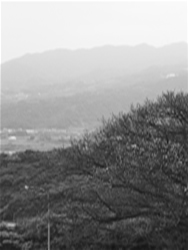
Soon after leaving the turmoil in China and arriving at Beitou, Ven. Master Dongchu started the monthly magazine Humanity. Soon after that, he founded the Chung-Hwa Institute of Buddhist Culture (CHIBC), organized the annual Winter Relief Drive, a committee to print the Buddhist sutras, and reprinted the Taisho Tripitaka (the most comprehensive compilation of the Buddhist scriptures in Chinese, edited by the Japanese during 1924-1934). Each development was pivotal in the history of Buddhism in Taiwan. What began a half century ago in Beitou gave birth to the future Dharma Drum Mountain.
Ven. Master Dongchu and the Chung-Hwa Institute of Buddhist Culture
The Hall of Culture in the Hot Spring Park
The story of Dharma Drum Mountain (DDM) began in Beitou. Before the midsummer of 1989, Dharma Drum Mountain was just a name. Nung Chan Monastery on the other hand, had already earned its reputation. People involved in Buddhism knew that in the midst of the famous Beitou hot springs area resided the Chung-Hwa Institute for Buddhist Culture (CHIBC), a center for research, and the Chung-Hwa Institute of Buddhist Studies (CHIBS), dedicated to education. The development of the Nung Chan Monastery, CHIBC and CHIBS in the recent twenty years is closely related to the story of DDM.
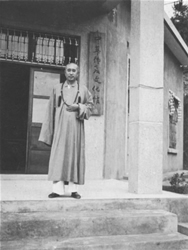 The Refreshing Hall of Culture
The Refreshing Hall of Culture
Located in the Beitou hot springs resort area that swarms with tourists, CHIBC manifests its unique character ─ its refreshing approach to promoting culture and education, its natural environment providing serenity and comfort. The famous Beitou Creek flows by the hill below the Institute and forms the most beloved area, the Hot Spring Park.
The Institute is surrounded by nature and greenery. The front pavilion, with its century-old camphor trees whose branches form a green canopy, has long been an enchanting spot. Later, teachers and students of CHIBS loved to contemplate and discuss under these magnificent trees.
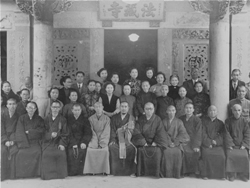
The little bridge, the hot spring, and the shade trees make up the scenery of Guangming Road. Ven. Jianxin, who followed Ven. Master Dongchu to Beitou in 1957, recalled her early years at the Institute:
Guangming Road was very simple. There was not much tourism. The hot spring hotels that appeared one after another were built much later.
Judging by her words, the Institute was quite an early inhabitant of the Beitou Hot Springs Park. The construction of the Chung-Hwa Institute of Buddhist Culture started in 1955 and was completed the next year. It is intriguing that Ven. Master Dongchu named his first Buddhist monastery in Taiwan the Chung-Hwa Institute of Buddhist Culture and avoided the more traditional names for monasteries. The name could possibly alienate the Buddhist supporters. Why did he think that way?
Ven. Master Dongchu's Compassionate Vows
Ven. Master Dongchu was born in Jiangsu province in 1907. He received a thorough formal Buddhist education and studied closely with several distinguished monks including Master Aiting and Master Nanting of the Zhulin Buddhist Institute in Zhenjiang. Ven. Master Dongchu then entered Minnan Buddhist Institute in Xiamen, and studied under Master Taixu. His peers included Yinshun, Zhumo, and Cihang (a.k.a. Tzuhang), all of whom became very influential. Master Taixu's Humanitarian Buddhism was becoming a big movement and revitalizing Buddhism in China.
After Master Dongchu graduated from the Minnan Buddhist Institute, he served as associate dean and dean of the Jiaoshan Buddhist Institute and as abbot of the Dinghui Monastery in Jiaoshan. The Jiaoshan Buddhist Institute was considered the best of its kind and it was an honor to graduate there.
Ven. Master Dongchu became the first permanent council member of the Buddhist Association of the Republic of China in 1947. Unexpectedly, within two years political power in China shifted and the situation was in turmoil. In response, Ven. Master Dongchu crossed the strait to Taiwan, as many monks and nuns also chose to do. In the rush, he brought only a few belongings, including an emblem of the Buddhist Association of the Republic of China.
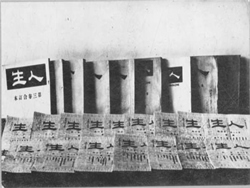
Fazang Monastery at Beitou became the temporary refuge for Master Dongchu. After only three months there, Master Dongchu launched Humanity, the first Buddhist periodical in Taiwan, its mission being to "purify the minds of the people and establish Life Buddhism." The resources he had were Master Nanting who wrote articles, Ven. Chengyi who oversaw the growth of the magazine from its birth, plus a few lay supporters.
The founding of Humanity surely brought new hopes to Buddhists in Taiwan. The magazine invited many senior Sangha members to participate and also cultivated many Buddhist authors that achieved prominence. Ven. Chengyi, who witnessed the growth of Humanity has said that, "by the second year, with its substantial content, Humanity had become the most popular Buddhist publication, with circulation reaching to Southeast and Northeast Asia, and America." During the political turmoil Humanity was a source of comfort and strength for the monastics who moved to Taiwan.
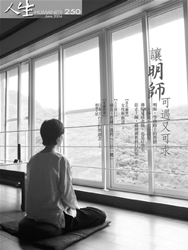
In 1955 Ven. Master Dongchu began building his first Buddhist monastery in Taiwan. While doing this he rallied influential Taiwanese society into forming the Tripitaka Printing Committee with the aim of printing the Taisho Tripitaka for the first time in Taiwani1. To let Buddhist devotees share the merits of printing the sutras and understanding the process, Ven. Master Dongchu organized teams that promoted the project throughout Taiwan, thus drawing much attention. Master Nanting and Master Xingyun were among these advocates.
In 1956, Ven. Master Dongchu's first Buddhist monastery was completed. To establish a broad foundation for cultural work, Ven. Master Dongchu refrained from calling it a Buddhist monastery, naming it instead, the Chung-Hwa Institute of Buddhist Culture. After half a century such enthusiasm for promoting the Dharma is still startling.
 Winter Relief Drive
Winter Relief Drive
Besides promoting Dharma from the cultural aspect, Ven. Master Dongchu had other thoughts about Human Life Buddhism. Fifty years ago, industry and business in Taiwan were still in early development and people were poor. Ven. Master Dongchu knew that very poor people could not even make ends meet. He decided that while compassion was the heart of Buddhism, it should be manifested concretely.
As a result, in 1956 Ven. Master Dongchu, who did not organize Buddhist ceremonies or chanting rituals for the dead to raise money, started a winter relief drive, the same year that CHIBC opened. He organized seven-day retreats for reciting the Buddha's name and collected donations to buy rice, cooking oil, winter clothes, and so on, and distributed the goods to the low-income households and orphanages in Beitou, Danshui, Sanchong, Yilan, Taoyuan, and Xinzhuang. This way, poor people could celebrate the Chinese New Year with at least food and warmth. Since then it has become a tradition to hold the winter relief drive as the Chinese New Year approaches.
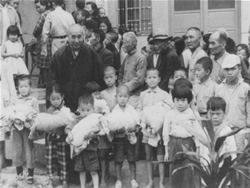 A Turning Point in Master Sheng Yen's Life
A Turning Point in Master Sheng Yen's Life
Master Sheng Yen had already taken part in the winter relief drive of CHBC before his auspicious relationship with Ven. Master Dongchu ripened in 1959. The young man had recently left the Taiwanese army and came to the Institute to pursue the monastic path second time, asking Ven. Master Dongchu to ritually shave his head. This was a turning point in his life and his impressions of the Institute, its culture, and its publications, have been captured in An Intellectual Autobiography of Master Sheng Yen:
At the time the only complete set of Buddhist scriptures of significant size in Taiwan was the Triptaka2 at the National Central Library. Besides that, only the Chung-Hwa Institute of Buddhist Culture was working on Buddhist culture and publications, including the replication of the Tripitaka, which was compiled by the Japanese during the time of Taisho era. The main edition and the sequel together consist of one hundred volumes. Five hundred copies of the Tripitaka were printed, and Zen Studies, a collection of fifty-nine Zen books from Japan, was reproduced by 1959. Ven. Master Dongchu was a scholar of Buddhist history. He wrote A History of Transmission of Buddhism between China and India, A History of Transmission of Buddhism Between China and Japan, and Modern History of Chinese Buddhism. It was hard to find a Buddhist establishment with such a large collection of Buddhist literature in Taiwan at that time.
The Founding of Nung Chan Monastery
Unexpected Finding of Farmland
After arriving in Taiwan, Ven. Master Dongchu did not spend much time performing ceremonies or leading practice, concentrating instead on cultural and charitable activities. In his later years he focused on writing the history of Buddhist culture and went out rarely. As a result he did not have large numbers of supporters. Despite this he was able to acquire property in the Guandu Plain near Taipei, on which he could build Nung Chan Monastery, thus manifesting his compassionate vows.
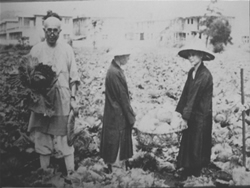
For the first few years after purchasing the 2.5-acre property, the only improvement Ven. Master Dongchu made was to have it leveled. Occasionally he would let disciples Dingxin and Jianxin grow vegetables on it. However, there is an interesting story about how Nung Chan Monastery began as bare farmland to become a center for the life of Chan-and-farming. When the land in Guandu Plain was leveled, it was fertile but lay fallow. Thinking this wasteful, the neighbors began to grow vegetables on it. Harvests were good and the locals wanted to continue farming, but Ven. Master Dongchu asked his disciples to recover the land.
The current abbot of CHIBC, Ven. Jianxin, recalls: "We planted young wax apple and guava trees along the perimeter of the land ... After one year, the fruit trees grew taller, and naturally fenced in our land." Over the next few years, they planted bamboos with Ven. Master Dongchu rolling up his sleeves, leading Dingxin and Jianxin step by step in developing the future of this farmland.

Finally, in 1971 Ven. Master Dongchu began to build a two-story, 1,800-square-foot farmhouse, which is now behind the main hall of the monastery. The first story contained the guest quarters, the reception room, and the second story was the Hall of Manjusri, the Bodhisattva of Great Wisdom. With the dedication of a statue of the bodhisattva, the Hall of Manjusri was completed in 1975. With the farmhouse built, Ven. Master Dongchu instituted the Chan-and-farming style of Nung Chan Monastery: "A day without work is a day without food." According to this principle practicing Chan is the goal, while farming is for sustaining life.
According to Buddhist scriptures, Bodhisattva Manjusri, "the Mother of all Buddhas," symbolizes great wisdom. The coincidence of Master Sheng Yen becoming the first bhikshu (monk) in contemporary Chinese history to obtain a doctoral degree was thus worth noting in connection with the new Manjusri Hall.
Master Sheng Yen Assumes New Responsibilities
In late 1977 Ven. Master Dongchu passed away sitting with no apparent illness. The news shocked Buddhist society in Taiwan. In Ven. Master Dongchu's will, he requested that Master Sheng Yen assume responsibility for CHIBC and for Nung Chan Monastery. By then Master Sheng Yen had gone to America to teach the Dharma after receiving his doctorate. In New York, Master Sheng Yen faced many new challenges: the culture, the language, the audience, and the approaches were unlike those of his past experiences. His explorations of these new challenges were suddenly interrupted by the request to return to Taiwan.

Upon his return to Taiwan, Master Sheng Yen immediately organized a new board of directors of the Institute. In 1978, he called the first board meeting, became the curator of the Institute, and organized two fundraising groups: the Compassion Foundation for Freeing Captive Animals, and the Guanyin Relief Foundation to secure the development of the Institute. After Master Dongchu's will had been executed for the short term, Master Sheng Yen returned to New York. Since then his custom has been to alternate every three months between Taiwan and the United States.
Ven. Jianxin of CHIBC has said, "Since Master Sheng Yen's return, he has been holding seven-day Chan retreats and conducting sutra studies. In a short time, the number of participants at the Institute has grown a lot and most notably, more and more young people are taking part."
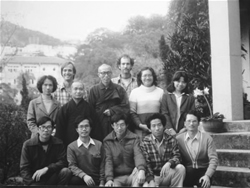
In 1978, Master Sheng Yen held his first seven-day Chan retreat in Taiwan at CHIBC. At that time the Chan hall and the dormitory could only accommodate twenty to thirty people. The early participants consisted of members of the Sutra Translation Instituteiii and college students2. As these students returned to school and shared their experience, more young people began showing up at retreats, as Ven. Jianxin has noted above. Thus, Master Sheng Yen's success at holding seven-day Chan retreats at the Institute has directly influenced the development of Nung Chan Monastery.
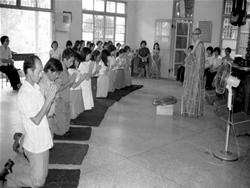
Eventually, the participants at the retreats began to include members of the general public. As a result, a larger facility became necessary and a temporary steel building was built to accommodate larger groups. The first practice group, the Prajna Meditation Society was formed with Mr. Xie Anjian as its first president. Later, more steel buildings were built, replacing CHIBC as the main venue for Master Sheng Yen's retreats, sutra studies, and Dharma lectures.
Teaching the Dharma in the West
New Life as Chan Master in America
In 1969 Master Sheng Yen went to Japan for advanced Buddhist studies at Rissho University, and in 1975 received a doctoral degroe. He had always hoped to foster Buddhist education in Taiwan, but his karma took him to the other side of the world, to New York City. There, Dr. C. T. Shen of the Buddhist Association of the United States had invited Master Sheng Yen to teach the Dharma at the Dajue Monastery, and he accepted. When Master Sheng Yen arrived there he was treated like any other monk, including performing chores. He also commuted by subway to English-speaking classes, which started with learning the alphabet. After six months Master Sheng Yen's English was not yet fluent, but the causes and conditions for teaching Chan meditation had ripened.
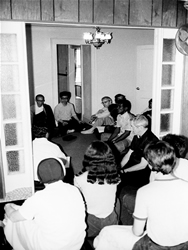
In 1976, when he became abbot of the monastery, Master Sheng Yen offered his first class in Chan meditation to Westerners. The participants were three young Americans and a Chinese named Wang Mingyi, who also served as translator. The following year, Master Sheng Yen held his first ever seven-day Chan meditation retreat at Bhodi House in Long Island, a private residence of Dr. Shen. Later, Master Sheng Yen remarked, "That was a successful Chan retreat ... though only nine people took part, three had very good experiences."
After Master Taixu taught the Dharma in Europe and America, he deeply felt that in the West there was an "abundance of potential sages, but a lack of means for cultivation." After this first retreat Master Sheng Yen also recognized the hard work and potential of Western students, confirming his belief in coming to America. The monthly Chan Newsletter and the quarterly Chan Magazine were started at this time and became important channels for Master Sheng Yen's teachings.
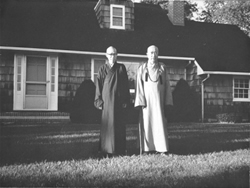 Passing of Ven. Master Dongchu and Aftermath
Passing of Ven. Master Dongchu and Aftermath
After two years of teaching the Dharma in New York, Master Sheng Yen had to abruptly return to Taiwan due to the sudden passing of Ven. Master Dongchu. As Dharma heir to Ven. Master Dongchu, he had many responsibilities and at first decided to remain in Taiwan, and ended his association with the Dajue Monastery. Since his American students wanted him to continue teaching in New York, Master Sheng Yen ultimately decided that the best course was to alternate his time between the East and West. Thus began his long-held pattern of spending three months in one place before returning to the other.
After taking care of Ven. Master Dongchu's legacy at least for the short term, Master Sheng Yen returned to New York. Having resigned from the Dajue Monastery, he now lacked a permanent base. During this time, taking along his meager belongings and sleeping bag, Master Sheng Yen stayed at the homes of lay supporters who extended their hospitality to him. Also during this time, he was able to continue giving meditation classes and lectures at a large studio in Greenwich Village that was the home of an American disciple. On Saturday mornings, students would gather there to meditate and hear Dharma lectures. One remarkable aspect of his teaching style then was to encourage students to talk openly about their practice experiences.
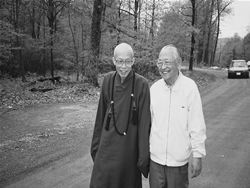
However, with support from benefactors such as Dr. Shen, Ven. Renjun, and a Mrs. Ying, Master Sheng Yen was soon able to rent a small apartment in Woodside, in Queens. Having attained stability in his living arrangements, Master Sheng Yen and his small group of disciples took steps to found the Chung-Hwa Institute of Buddhist Culture (not to be confused with the organization in Taiwan), also known today as the Chan Meditation Center (CMC).
In the following year the Institute acquired a very old two-story building in Elmhurst, also in Queens. The Master and his disciples worked very hard for two years to transform the dirty former factory into a thriving practice center. The filthy, grease-stained basement became a clean kitchen with a large dining room. Much of the electrical system and all of the plumbing were replaced. The first and second floors became spaces for gatherings, retreats, and Dharma lectures. The main hall on the first floor could accommodate up to thirty people for retreats and about a hundred for lectures and gatherings. CMC officially opened in 1981 on the Buddha掇 birthday, attracting over a hundred people. It was also called Dongchu Chan Monastery, in honor of the late Master.
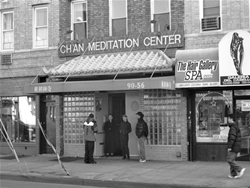
The Chan Newsletter and Chan Magazine, which were established while the group was still at the Dajue Monastery, continued publishing at the new CMC. Eventually the Newsletter was merged into Chan Magazine. During this period, a decision was made to compile a book in English based on some of Master Sheng Yen's retreat lectures. This book was eventually published as Getting the Buddha Mind, Master Sheng Yen's first book in English. Most significantly, CMC published the book under its own imprint, called Dharma Drum Publications.
A few short years later CMC moved to its current location, a three-story building just across the street. Some time after, a house behind the CMC was purchased as living quarters for nuns and female residents, while monks and male residents lived in the main building. As always, amenities are very austere and the residents live a simple life at CMC while serving the Sangha. While there is no farm attached to the Center, everyone at the Center works at specific tasks as part of their practice of "day without work is a day without food." Since the late 1990's retreats have been held at the Dharma Drum Retreat Center (DDRC) in Pine Bush, New York, but at the Queens center the biggest problem today is having space to accommodate the large numbers of members, practitioners, and guests who attend Sunday services as well as Buddhist holidays.
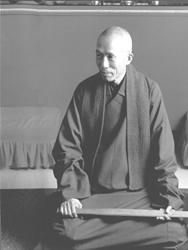
Bringing Out the Spirit of Dharma Drum Mountain
As Master Sheng Yen's reputation as a Dharma teacher grew in the West, more and more Chinese and Westerners came to CMC to learn about the Dharma and practice Chan. Today CMC also offers sutra studies, devotion to Guanyin, chanting society,as well as classes in Buddhist philosophy, yoga, Tai Chi, and calligraphy. In addition, CMC has in place programs for training meditation instructors and Dharma lecturers.

As the development of Dharma Drum Mountain proceeded in Taiwan, CMC was not only the Master's base in the United States, but also the precursor of some of the practices and events of the sort later held at DDM. For example, Chan retreats and transmission of the bodhisattva's precepts were offered at CMC in New York before being offered at the Nung Chan Monastery in Taiwan. In 1997, the newly opened DDRC in Upstate New York became another important venue for Chan medi tation practice.
The Founding of the Chung-Hwa Institute of Buddhist Studies
Buddhist Education Germinates in Taipei
Master Sheng Yen's return to Taiwan in 1978 caught the attention of Dr. Zhang Qiyun, founder of the College of Chinese Culture. Dr. Zhang sent the president of the college, Dr. Pan Weihe, and Prof. Li Zhifu to offer to Master Sheng Yen the directorship of the Institute of Buddhist Studies at the China Academy of the College of Chinese Culture. Since the center in the United States had just opened and he had recently taken over CHIBC and Nung Chan Monastery in Taiwan, Master Sheng Yen's available time and energy were already stretched thin. So he at first politely declined the offer.
Prof. Li and Fang Ningshu, one of Ven. Master Dongchu's lay disciples, immediately offered to Master Sheng Yen any help he might need as director. These two contemporaries of the Master's were there for the founding of the CHIBC, CHIBS, and eventually DDM, and have since become two of the Master's most important and reliable friends. They are also favorite elders, respected by devotees of DDM.

The Huayan Lotus Society was among the most important benefactors to Buddhist academies at that time. Upon Master Sheng Yen's sincere request, Ven. Chengyi agreed to be vice director. He guided the members of the Huayan Lotus Society in underwriting most of the Institute's founding expenses. Master Sheng Yen recalls with appreciation the dedication and diligence of Ven. Chengyi and Master Nanting in promoting Buddhist education. Not only did they advance Ven. Master Dongchu's cultural work thirty years ago, they are today still looking after Ven. Master Dongchu's Dharma "family" by supporting Master Sheng Yen's vision of Buddhist education. For twenty years without a break, when Master Sheng Yen returns to Taiwan for the Chinese New Year, he visits the two elders to thank them.
After accepting the directorship, Master Sheng Yen began changing the emphasis from research to education. Back in 1981 the Institute began accepting students but had to cease in 1984 due to the original founder's poor health, and the restructuring of the college. This change inspired Master Sheng Yen to consider establishing an educational institute himself, so in 1985 he founded the Chung-Hwa Institute of Buddhist Studies, and placed it temporarily inside the facility of CHIBC.
Rebuilding CHIBC
The original CHIBC building in Taiwan contained less than 7,200 square feet, was irregularly shaped, and impractical. Ven. Master Dongchu's wish to relocate and establish a well-run institute on a hillside away from the cities was never fulfilled in his life. In 1985 conditions had ripened for Master Sheng Yen to rebuild, but location was still a problem. Land was scarce in the suburbs and the Institute itself is a foundation, that Taipei city had certain restrictions on, both making it difficult to relocate. Since there was a dire need for more space, Master Sheng Yen decided to rebuild the Institute.
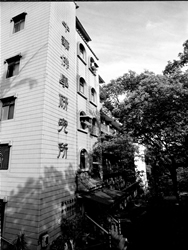
But luckily, with the help of the Hansheng Construction Company, whose owner was a devoted Buddhist, an agreement was made for the Institute to provide the land and for the Hansheng Construction Company to build the facility, as well as granting a loan to buy some of the surrounding acreage. The new five-story building was completed in 1986 with about 18,000 square feet of space and dormitories for faculty and students. Before moving to the new DDM site in September of 2001, CHIBS had been in the good hands of the CHIBC for sixteen years.
The Tradition of Chan and Farming
Nung Chan Mastery has occupied the same 2.5 acres since its beginnings, but its buildings have gone through many changes.
A Hall that keeps growing
During the rebuilding of CHIBC that started in 1984, many activities were moved over to Nung Chan Monastery, which itself was not large. The two-story farmhouse had less than 3,600 square feet of space, not enough to accommodate group living and practice for the Sangha and laity. Fortunately the Hanshen Construction Company and followers helped by erecting several temporary steel buildings. Master Sheng Yen said, "Though the monastery looks quite rustic, people who come here still like it ... This is a temporary arrangement, but what in the world is not temporary? It is fine as long as it works."
Spiritual Shangrla
 The Tradition of Chan and Farming
The Tradition of Chan and Farming
Nung Chan Mastery has occupied the same 2.5 acres since its beginnings, but its buildings have gone through many changes.
A Hall that keeps growing
During the rebuilding of CHIBC that started in 1984, many activities were moved over to Nung Chan Monastery, which itself was not large. The two-story farmhouse had less than 3,600 square feet of space, not enough to accommodate group living and practice for the Sangha and laity. Fortunately the Hanshen Construction Company and followers helped by erecting several temporary steel buildings. Master Sheng Yen said, "Though the monastery looks quite rustic, people who come here still like it ... This is a temporary arrangement, but what in the world is not temporary? It is fine as long as it works."
As Master Sheng Yen's reputation grew, more and more followers came to the monastery. In a few years, the number of people at a single event reached a few hundred, at times over a thousand. Because it was often packed, the main hall went through several expansions before achieving its current spaciousness. The main hall which was on the second story of the orginal farmhouse was moved into one of the steel structures, which then went through a few expansions. "It's like clothing that stretches as the person grows ... it's very interesting!" said Ven. Guoxiang, a disciple since his ordination in 1980. Like a monk's robe extending to protect everyone, the main hall expanded as the number of participants grew.
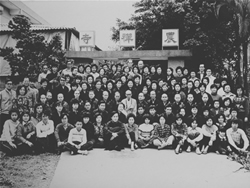 A New Trend in Practicing Buddhism
A New Trend in Practicing Buddhism
Many old-timers must remember the scene of Nung Chan Monastery surrounded by rows and rows of bamboo groves, rice paddies, and vegetable gardens. Isolated at the end of a small lane off Daye Road, Nung Chan Monastery is well known. Still, first-time visitors may not know the address when coming, but know it's a place "down some lane around the Guandu Plain," or "off some road close to a shrine of the genius loci." Liao Jinrong, who first visited the Nung Chan Monastery in 1984, found the entrance of of lectures known as "the Three Little Gates" only after repeatedly asking for directions.
By the time of Ms. Liao's first visit, the monastery had been offering beginner's Chan courses, meditation, and chanting of Buddha's name. Ms. Liao at first thought the Dharma events she participated in only required her to fill out the names of the deceased to be dedicated to. She was surprised to learn about group practice. Before leaving that day she was given a sack of shoots by Ven. Jianxin that came from the towering bamboos surrounding the monastery. Ms. Liao felt very happy on the way home. Ms. Liao has since become leader of the Merit and Wisdom Chanting Society, the second Dharma practice group at Nung Chan Monastery.
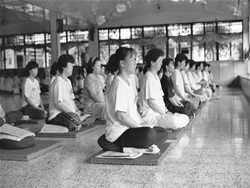
Another feature of Nung Chan Monastery at that time is that whenever the Master came back to Taiwan from the United States, he would continuously give Dharma lectures for three nights, and lead the Sunday sutra study. which were unforgettable in the minds of the devotees. In the fall of 1984, Master Sheng Yen began a series of lectures on the Vimalakirti Sutra which took over five years to complete. Later, he lectured on such Mahayana sutras as the Diamond Sutra, the Heart Sutra, the Sixth Patriach's Platform Sutra, and the Lotus Sutra. These lectures all enhanced the monastery's reputation.
News that a 'doctor bhikshu' was teaching Chan and sutras at Nung Chan Monastery was spreading. After much searching, people who wanted to learn and practice Buddhism would end up there. Many were intellectuals and urban middle-class people. Learning Buddhism had become a new trend in metropolitan Taipei. The late Buddhist writer Chen Huijian wrote: "The form of Buddhist practice at Beitou's Nung Chan Monastery led by Master Sheng Yen had never been seen in Taiwan before... The Chan practices are two-waved (summer and winter) and focus on people of culture."
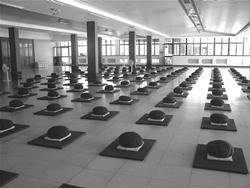
By 1989 when DDM was founded, Master Sheng Yen was leading his followers in promoting Humanistic Buddhism and had accomplished much in the culture, education, spiritual practice, and charity.
In publishing, Dongchu Publications in Taipei and Dharma Drum Publications in New York were founded, publication of Humanity was resumed, and Dharma Drum Magazine was started. In Memory of Ven. Master Dongchu was published on the 10th anniversary of the Master's passing.
In education, CHIBS was founded for training educators of advanced Buddhism; the Three Studies Institute was formed within Nung Chan Monastery to train future Dharma teachers and upholders of the Three Jewels. In 1979, Master Sheng Yen defined the mission of The Three Studies Institute:
The mission of the institute is to cultivate young Buddhists in the three studies of the precepts, meditation, and wisdom.
Students of the institute should possess the qualities of purity, diligence, abstinence, non-contentiousness, cleanliness, calmness, compliance, harmony, self-motivation, self-discipline, and self-determination. They should respect and help each other; be honest, forgiving, and resourceful to each other; and help each other improve, so that they can attain the noble goals in spiritual and academic development.
Students should conserve the properties of the institute, and take interest in the welfare of the public. They should refrain from acquiring connections with worldly affairs or going outside for entertainment unless required by work, study, or services to the public. Students should try their best to accomplish the assigned work, so that they can cultivate merit and wisdom, and the vows to uplift the Dharma and benefit all the living beings.
In social work, besides the continuation of the winter relief drive, the Merit Fields Society was formed to serve charity cases.
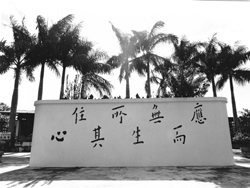
In spiritual practice and teaching the Dharma, there were Chan retreats, Buddha's name recitation, sutra study, and Great Compassion Repentance Ritual. Dharma lectures in large venues such as universities and public places have changed the image of traditional Buddhism in the minds of the public.
Ven. Master Dongchu's vow to promote Human Life Buddhism started with cultural and charitable activities, but his ultimate goal of advancing the education of the Sangha remained unfinished during his life. Now, his most prominent disciple, Master Sheng Yen, has achieved parallel goals in education, culture, charity, and spiritual practice within ten years after returning from the United States. He has fulfilled the legacy of his Dharma teacher and returned the favor. Prof. Fang Ningshu, who had close relationships with both Ven. Master Dongchu and Master Sheng Yen for fifty years, and has observed the development of CHIBC, Nung Chan Monastery, and Dharma Drum Mountain, has said, "Ven. Master Dongchu brought the seed of Chinese Buddhism from the Mainland to Taiwan and it started growing roots here.... Now Master Sheng Yen has further spread the torch of Buddhism to the rest of the world and has developed the vows of Ven. Master Dongchu to a even higher stage."

|